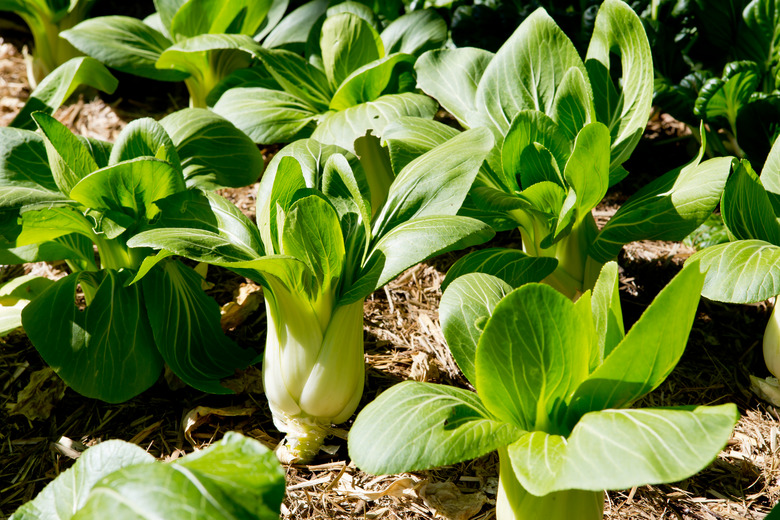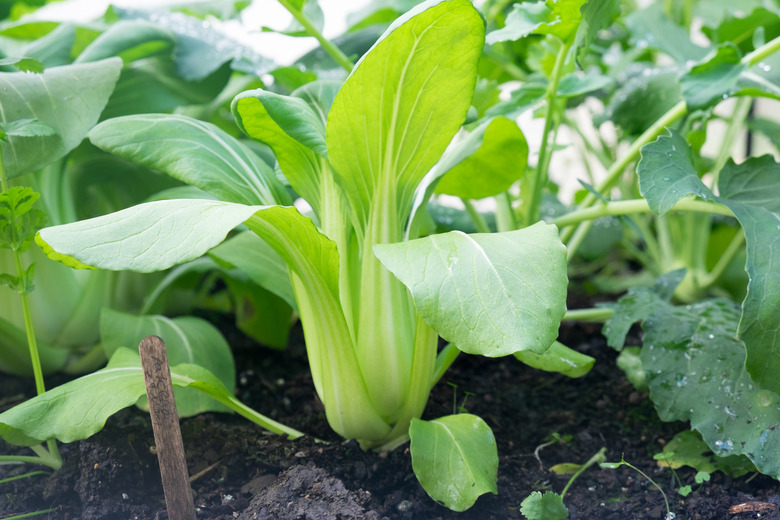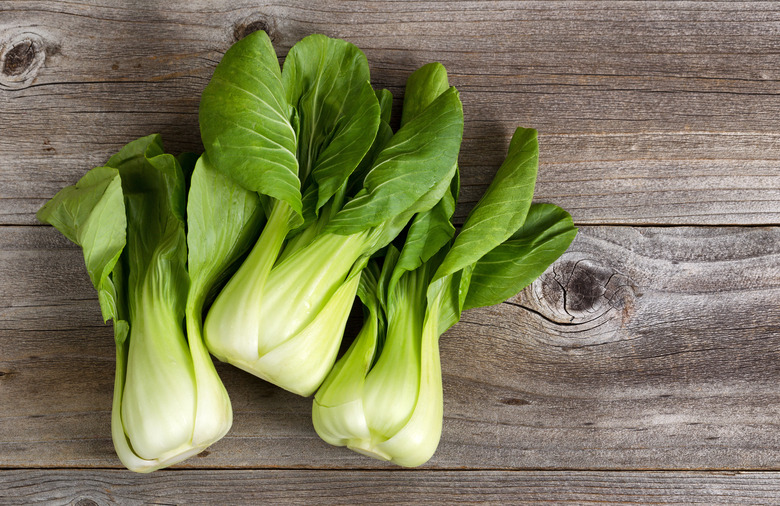How To Grow Bok Choy
Bok choy (Brassica rapa [Chinensis Group]) is a type of Chinese cabbage that in recent years has moved from Asian ethnic specialty stores to mainstream markets. Although bok choy is a biennial, it's grown as an annual in U.S. Department of Agriculture plant hardiness zones 2 through 11. This cool-season veggie grows an upright clump of green leaves, each with a thick white or light-green stalk. The plant can take some chilly weather short of a hard freeze and is a great choice to extend the late-summer garden.
Best Uses for Bok Choy
Like their cabbage relatives, bok choy plants are usually reserved for the vegetable garden and are then taken to the kitchen after harvest. Served as a crunchy, leafy addition to stir fries, bok choy is a popular choice for home chefs. It's possible to plant bok choy in containers, but very few gardeners would select these Asian greens for their ornamental value.
How to Grow Bok Choy
- Common Name: Bok choy
- Botanical Name: Brassica rapa (Chinensis Group)
- When to Plant: Plant this cool-season crop in late summer so it can mature in early fall. Spring crops often bolt (send up a flower stalk and produce seeds).
- USDA Zones: Grown as an annual in zones 2-11
- Sun Exposure: Partial shade
- Soil Type: Organically rich, well-draining soil
- When it's in Trouble: Bolts during hot weather or drought
- When it's Thriving: Fast-growing, smooth green leaves and crisp stalks
Starting Bok Choy From Seed
Experts recommend that you sow bok choy seeds shallowly, no deeper than 1/2 inch. For dwarf varieties, sow seeds in groups of three every 12 inches. For full-size plants, space the three seed groups 18 inches apart. Select a growing site where you haven't grown any other Brassica crops in the prior four years. This includes cabbage, broccoli, cauliflower, turnips, rutabaga and Brussels sprouts.
For fall crops, direct seed bok choy in your vegetable garden in July. For cold-winter states, count back 60 days from the date you expect the first hard frost. Once seeds are sown, regular irrigation is required. You must keep the soil moist through germination. Bok choy seeds germinate rapidly, usually within four to eight days.
Once seedlings emerge, it is time to thin out the plants. Remove weaker seedlings to leave only one seedling in each planting area. The seedlings are very vulnerable in their earliest days. You'll want to coddle and protect them in case of heat, wind or drought. Light row cover can offer the seedlings protection in their first few weeks of growth but be sure to secure the cover firmly.
It is also possible to sow bok choy seeds in spring, but the crop frequently bolts as the weather warms. Bolting makes the vegetable bitter. For spring planting in areas with cold winters, start the seeds inside and don't transplant outside until all possibility of frost has passed.
If you are starting your bok choy crop from seedlings you grew indoors, transplant them to the garden once you see that the plants have formed several true leaves and if all danger of frost has passed. Gradually harden off the seedlings, leaving them outdoors for increasing periods each day for a week before installing them in the garden bed. If you are using starts from the garden store, they will be ready to transplant when you get them.
Plant the seedlings in the garden and space them appropriately. Dwarf plants can be placed 12 inches apart, while full-size plants require 18 inches. Make sure the plants remain at the same level in the soil as they were in their growing containers.
In What Zone Does Bok Choy Grow Best?
Bok choy can grow well as an annual in most states regardless of the zone. However, the optimal timing of the planting may be different in different areas given the temperature. In all cases, a hard frost is likely to kill the plants, so zones with warmer winters will have a longer growing season. In warmer zones, planting in shade may help to prevent bolting.
When Should You Plant Bok Choy?
The timing of planting is a matter of climate. In most growing zones, it is best to plant bok choy in the fall. This type of Chinese cabbage is a cool-weather crop, so in most regions, spring and fall are the best options. You may get the best-tasting bok choy if you plant in midsummer, allowing the plants to mature in the shortening days and cooler temperatures of September or October. However, the fall season can be cut short when the first hard frost occurs.
Similarly, a spring crop is also bounded by the final hard frost. The plants should not be set outside in spring until the final hard frost is over. Even a short freeze followed by hot weather can cause the plants to go to seed, making them inedible. Summer heat and drought may also cause the plants to bolt.
For a maximum bok choy crop, you might use succession planting, seeding every few weeks in spring, stopping when the weather gets hot and starting again in midsummer for an autumn harvest. In some warm-winter regions, it may be possible to plant bok choy year-round.
Soil, Sunlight and Water Recommendations for Bok Choy
Bok choy needs well-draining soil that is rich in organic content to hold in moisture. The soil should have a pH between 6.0 and 7.5. In order to produce a good crop, this type of soil is essential. Improve your soil by adding organic compost or well-rotted manure before planting. Do not use fresh manure for this crop since it can bring in bacteria and never use a "weed and feed" fertilizer because it can kill the plants.
Sunlight is important, but too much sun and heat will cause the plants to go to seed. Put the plants in a site that gets three to five hours of sun a day. Ideally, give them a spot with shade in the afternoon.
A steady water supply is essential. The plants need to absorb water and nutrients steadily during their growth, so be sure they get 1 inch every week and more if it's hot or if the soil is sandy. If the plants do not get enough water, the leaves will be bitter and tough, and outer leaves may dry up entirely. Uneven soil moisture can result in tipburn.
How to Harvest Bok Choy
Generally, bok choy is ready for harvest between 40 and 60 days after seeding depending on its type and cultural factors like temperature, available moisture and soil fertility. The bigger varieties can grow to 24 inches tall, while dwarf and baby bok choy is full grown at under 10 inches. A plant is mature when it has 10 to 15 leaves; with more than 15 leaves, it may be bitter.
Harvest by cutting the plant near the soil surface. In a home garden, count on multiple harvests, taking bigger plants (with 10 to 15 leaves) first and allowing the smaller plants to continue growing. Mature leaves should be dark green and upright, with crisp, wide stems.
It is also possible to harvest a few leaves at a time instead of harvesting the entire head. If you want to harvest leaf by leaf, harvest the big leaves from the outside of the plant first, leaving the younger leaves for later. Some gardeners like to eat baby bok choy and will harvest the smaller, younger leaves.
Common Pests and Other Problems for Bok Choy
Bok choy is a crop with a relatively short growing period to maturity, but that doesn't mean it avoids insect pests. In fact, a number of insects attach to plants in the Brassica family.
- Aphids: These tiny bugs can show up in great numbers, and they suck the juices from the plant leaves. They usually hit spring crops left too long maturing in the hot sun. Avoid them by harvesting the crop earlier.
- White cabbage moths: These insect pests look like flitting white butterflies, but they are among the worst enemies of Brassica plants. The moths lay their eggs on the lower side of Brassica plant leaves, and the hatchling larvae (white cabbage worms) chow down on the plants. You can pick off the worms or protect the crop with netting.
- Tarnished plant bugs: Another plant-juice-sucking insect pest, this one is unique in that it also injects bok choy with a
toxic substance that distorts the leaves. Weeding well is a good way to prevent an infestation, but white sticky traps take out a current infestation. - Flea beetles: This miniscule jumping beetle creates "shot holes" in leaves and can spread disease. The easiest solution is to use white sticky traps to catch and kill them.
- Whiteflies: Whiteflies
are a little like aphids and suck the juices from bok choy leaves. Yellow sticky traps can capture these pests, and ladybugs will happily eat them. - Leafminers: These tiny insect pests "mine" tunnels through plant leaves.
Spray the plants with neem oil to banish the bugs, making sure to observe all label directions and precautions.
Common Diseases for Bok Choy
- Downy mildew: Downy mildew is not related to powdery mildew despite the similar names. It can appear as yellow spots on the top of growing bok choy leaves and/or white spots on the bottom. The best way to control downy mildew is through prevention, which means watering from the bottom and not from above. When water sits on the leaves, the mildew can infect the plant. Another prevention tip is to clean out all dead plant material in your garden area. If your plants become infected with downy mildew, a copper spray may help.
- Clubroot: Clubroot
is a fungal disease and is no stranger to the Brassica family. It causes the roots to become misshapen and the plants to droop during the day even if you provide sufficient water. Prevent clubroot by weeding regularly and rotating your crops. You'll have to dig out and dispose of any infected plants. - Mosaic virus: If your bok choy shows wrinkled leaves that are yellow or discolored, it could be infected with this virus. Look in particular for yellowing of the leaf veins. Plant virus-resistant varieties of bok choy. There is no cure.
- Alternaria leaf spot: Brown spots on leaves may mean an infection. You can treat it with copper fungicides.


